Excerpt from Oscar of Between, Part 14B
by
Betsy Warland
Then there’s the gun. In its dusty, fake-alligator-hide case. She’s been in a quandary about it for years. How to get rid of a gun? There’s the practicality of the dilemma but also the emotional trigger it sets off.In the twelfth year of Oscar’s life her Aunt Lyla advised Oscar’s mother to send Oscar (perhaps a too solitary girl of the farm and woods) to the YWCA summer camp. This is when she first encountered the fierce jockeying for popularity among girls — girls from cities and large towns who had attended the camp before and who came with friends. Within the first hour she does something she’d never even thought of before: she changes her name. Does it instinctively. Desperately. Had to become someone else. Becomes “Rusty.” Since popularity wasn’t an option maybe a surprising name might help. The other girls respond with at least some faint curiosity.After breakfast the first morning each girl must select a set of daily activities. A novice in all, Rusty chooses canoeing, water skiing, target shooting. She soon excels at skiing. At the end of the week, her canoeing group sets out on a two-day wilderness trip. Rusty is stunned by how the other twelve-year-olds set their alarm clocks a half hour early to meticulously apply their makeup before breakfast. Someone also steals her hard-soled moccasins.
Target shooting (another foreign activity) goes better. At the awards dinner she receives the Deadeye Dotty Award for the highest scores for marksmanship.
That Christmas she had only one request: a .22 rifle. Her mother adamantly refused. “What would people think?” But on Christmas Eve, after all the presents were opened, her father said, “I think there’s one more for you, Betsy, back under the tree.” It was a long, narrow package. Could it possibly be? Oscar could barely contain her giddiness as she tore off the paper and pulled the gun out of the box. She glanced up: saw her father’s smile.

Photo credit: Unknown
He had seen her. As she was.
Now, as Oscar frets about what to do with the gun, she tells Sophie the story of the two gifts. For her seventh birthday, Sophie’s only desire was for a Barbie doll. The very thought made her mom cringe, so Mary (a longtime friend) asked Oscar (who was Sophie’s godmother) to do the deed. After her own recoil, Oscar recalled her father and the rifle. Her turn to bite the bullet, she bought the Barbie.
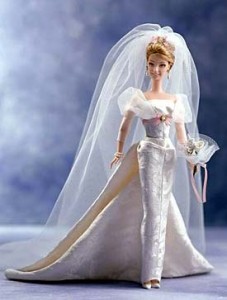
Photo Credit: https://s524.photobucket.com/user/cangyuewing/profile/
Sophie and Oscar decide to take a break after a few hours of sorting. Go back to Oscar’s for a bite.
The rifle.
She cannot postpone this decision any longer. There’s no one who wants it and her young son has fortunately shown no interest in guns. While Oscar makes their lunch, she asks Sophie to call a few gun stores to see if one might buy it.
A shop at 16th and Fraser is interested.
Upon returning, they finish loading the car with objects Oscar’s moving back to her apartment. The gun is the final task.
Silently driving to the store, a peculiar kind of nervousness is circling around them. When they walk into the narrow shop their discomfort increases: it’s teaming with customers. Some are the type of men you would anticipate; many are not. The mood is one of contained excitement. The conversations between staff and customers, and customers with other customers, are intensely focused. Sophie and Oscar barely speak, each as uncomfortable and out of place as the other. A young man next to them effortlessly spends $800. Oscar wonders, “What am I doing here?” and fights the urge to leave. Goes through the reasons again: it’s worse to throw it away. Who might find it? Use if for what? Better to have it registered.
Odd how difficult it is to get rid of dangerous things.
The store buyer finally has time to wait on them. He takes the gun into the back room to inspect it and run a security check. Returns and offers Oscar $50. As he hands her the crisp red bill Oscar stalls inside herself with a small grief then recognizes that this story of two gifts suddenly makes sense.
Sophie is already eagerly heading for the door.
Oscar calls out, “Sophie?”
Sophie turns around as Oscar catches up and hands Sophie the crisp red $50. Sophie’s face flushes with surprise.
“Why are you giving it to me?”
“It’s yours. The rifle. The Barbie. This is how the story ends.”
Twenty years post-Barbie, Oscar is revising this for her February 2014 Oscar Salon. It’s then that she recalls another connection between rifle and Barbie. She does an online search to confirm it. It’s true. The engineer Mattel hired to “re-think the design of a German doll called Bild Lilli” had previously designed missiles. Oscar finds an image of a 1993 Barbie, then an image of her .22 rifle’s vintage. Rotates the .22’s image so that the barrel points down.
Missile, Barbie and .22 share the same shape.
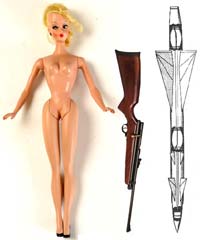
Compilation image: Bild Lilli doll, .22 caliber rifle, 1956 Nike missile. Bild Lilli photo credit: https://www.marcdolls.ch/englilli.html
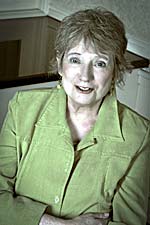
Guest Writer:
Myrna Kostash
Edmonton, AB
www.myrnakostash.com
I had a gun once. It was a .22 something-or-other, the gift of the farmer, Pete Kereluk, who rented my land and didn’t like the idea of my staying alone. My property was on a secondary road and you could easily see my shack as you drove by, but this very visibility is what might have given some of the “boys” riding around in their pickup trucks some ideas, according to Pete. So he handed me the rifle in its already-opened cardboard box. It was surprisingly light, balanced tentatively on my hands, but then I saw it was made mainly of plastic, which, I admit, disappointed me. It felt like a toy (maybe it was for girls?) until I felt the whump of it recoil against my right shoulder as I took my very first shot, ever, from a firearm. I couldn’t believe I had done it and I examined with some wariness the small box of elegant bullets, packed in tight rows, that could kill a deer and most certainly a squirrel. Could a .22 kill a man?

Photo credit: unknown
Of course, I never intended to shoot anything except a tin can on a fence (a pastime I saw in Western movies) but Pete took his training responsibility seriously and insisted I practise first by shooting at the half-hinged door of the old barn across the little meadow from my shack. I thought this was a risible “target” — how could you miss it? As soon as Pete drove out of the yard, with a tip of the finger to the brim of his Co-op cap, I rummaged around in the shack for something that looked like a real target, something that had enough details or features on it so that I could measure how well I was doing from large to smaller target points. I don’t remember what the choices were but I do remember that I chose a large poster of the famous portrait of Karl Marx that many of us had up on our bedroom or study walls, along with Che Guevara and, in my case, Hanoi Jane (Fonda). It was rolled up in a corner.
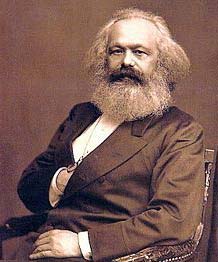
Photo credit: International Institute of Social History in Amsterdam, Netherlands
I nailed it up on the side of the barn and shot away. I meant no disrespect.
Email from deer hunter Harvey Spak: “Your rifle was .22 caliber semi-automatic meaning it fired every time you squeezed the trigger. It had a magazine that you loaded with perhaps 10 .22 cal long rifle cartridges. Once the mag was loaded, you inserted it into the receiver just ahead of the trigger guard till it snapped home. Then you cocked it, i.e., you drew back the bolt on the receiver just above the trigger guard and were ready to fire. When you were ready to shoot you clicked off the safety and fired.”
One day my friends, the poet from Wood Mountain, Saskatchewan, Andy Suknaski, and deer hunter Spak rolled up for a visit. While Andy tamped his pipe and gazed out the little window that looked south to the old barn, he saw Karl, and kind of yelped. Later he wrote a poem, “Marx’ Woman”: she hands suknatskyj/her rifle/’try that tin can/on the barn windowsill/gun’s ready/just flip it off saftyMYRNA: this spelling in the original/the red dot/should be showing’/PTZWWWAAAaaaaannnnnnng!/on the garden’s edge/the sunflowers stand/motionless/like a firing squad/behind her.
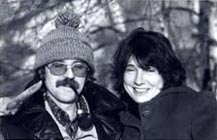
Karl marx/winces/frowning at the hopeless/marksmanship/of suknatskyjMYRNA: Suknaski's poem comes from the collection In the Name of Narid, published in 1981 by Porcupine's Quill Press in Erin ON p 48
I kept the gun under my bed with the loaded cartridge in the drawer of the little bedside table. How fast did I think I could load it? One day a friend originally from Montreal paid me a visit. I showed him the .22, with the same satisfaction I showed him the red Olivetti portable typewriter primed for work on the little desk. My friend was unimpressed. He was from the big city, and savvy. “If you’re going to have a gun around, be prepared for it to be grabbed from you and used on you.” I had never thought of that. I took my .22 into the city and handed it over to the police. After that, I slept with an axe under the bed.
Email from deer hunter Spak: “I question the self-defence advice given you by your Montreal dude. If an attacker could wrestle away your rifle and use it against you, he would have less trouble taking away the axe. You’d have first advantage and a longer reach with the rifle than with a 2 ft axe. And if he got the axe away Bozhe! Bozhe!” Lord! Lord!

Featured Reader:
Susan Young
Vancouver, BC
susancolleenyoung.wordpress.com
I read Oscar’s Salon because…
I read Oscar because it’s brave and quietly fierce and always surprising; a conversation that I continue in my head long after I’ve finished reading.
Profile
Susan Young is a poet and fiction writer living in Vancouver. Her first two stories were published in The New Quarterly, “The Perfect Age,” (118) and “When Genghis Khan Was My Lover” (125), the latter a runner up for The Peter Hinchcliffe Fiction Contest.
Her poems have appeared in The New Quarterly, Room, Event, The Antigonish Review, CV2, Prairie Fire, Poetry Canada and the anthologies, Desperately Seeking Susans, Chasing Halley’s Comet, and Vintage 97/98. Her poetry manuscript, In the room that became a forest, received an Honourable Mention in the 2009 Alfred G. Bailey Poetry contest.




Ah Betsy,
You had me. When my fiancé died I had to ‘dispose’ of his two hunting rifles from when he lived another life up in the NWT. I recall the fear of having to pick them up, then carry them from my car into that same store on Fraser.
I wanted to cry out, “These aren’t mine,” as I entered, but of course, no one would have cared; they were all completely engrossed in the world of guns.
I was an elementary school teacher. I dreaded someone coming in, of recognizing me. (Don’t make me mad, Johnny. Teacher’s got a gun.) Mostly I was scared I’d get shot by some masked intruder.
Reading your tale took me back there.
P.S. I think they gave me $150 for the pair (they were sold on consignment) but it felt like dirty money.
Betsy,
When I read this it reminded me of two things. I once wrote a story for the newspaper in Salmon Arm where I worked as a reporter. I was a city girl. I had no direct experience with guns.
I recall the RCMP officer I was interviewing me telling me that the most dangerous guns are the ones left in a house after the original owners had died or old hunting guns that people forgot were even around and weren’t properly stored/locked up. He said they get stolen, people use them to commit suicide, there are accidents and sometimes intruders steal them or use them against the people who forgot they were even in the house. He freaked me out. I’d never thought of such things.
I do recall being introduced then to the huge philosophical difference between the attitudes of about guns between rural versus urban residents. In the city, guns get associated with personal protection and violence and mostly via Hollywood movies. Whereas in the country, hunting deer,elk, gophers, was justification to be a more legitimate reason for owning gun(s).
The other thing that stood out for me is your description of your camp experience. I went to a camp called Camp Mosquito (that should have been the first sign) when I was about 10 years old and even though I went with a friend, I ended up being put into a tent with two little princesses who cared about their hair and who brought make-up with them. They spent hours in the tent staring into a mirror it seemed to me. It confused me. I didn’t know 10 year old girls (back then) who cared about such things and hadn’t been around any who had prior to that experience. I hated it. I never went to camp again.
I felt amazed to read what you wrote, Betsy, wondering how it was possible that we both experienced that at a summer camp. My friend later told me that all the camp counsellors were fired after we returned. I’m not sure if that was true or I just made that up to help myself feel better afterwards. Great story about a gun, Barbie, “biting the bullet” and $50.
A great story held by connections between your childhood and Sophie’s … I also enjoyed the “lighter,”mirroring piece from Myrna Kostash. Thanks for gathering your collaborators and sending these pieces out to all of us.
i think i’m beginning to sense from dipping in and out of the salon with its steady monthly stroke how oscar’s sensibilities travel subterraneously through me as reader & mesh with my memories of expectations of being a girl.
having a twin brother who mostly i felt equal to except when it came to strength & having to wear a bikini top while he continued to just wear trunks—with my closest girlfriends we were all ‘tomboys’ because that allowed the most freedom it seemed. i too was to be amazed when i took my daughter & her 12 year old friends camping, and out came the make-up—at their age we weren’t interested. developing breasts was a challenge to my agility & swiftness—a conundrum of the body changing shape that maybe still confounds me.
they enter unwillingly each others’ territory, different cultures alarmed at border crossings, armed and sometimes—disarmed.
both these pieces disarm me—& myrna, i’m impressed you thought of using marx—the poster i had alongside his & che’s was angela davis.
I know I should probably post something about guns, like the time I drank moonshine and shot a .22 (both for the first time) to impress a bunch of guys. But what I can’t stop thinking about after reading this, is summer camp.
My whole family went to French immersion summer camp, so there was none of that separation anxiety that other kids must have felt. For the first few years, I didn’t make any close friends, but finally I met a girl who I spent a lot of time with. Michelle.
“Are you a boy or a girl?” The first question she asked me.
“Girl.” I grumbled. But we still managed to hit it off. 🙂
Every summer, my mom insisted on cutting my hair short, and I hated it. She said it was because she hated brushing the knots out, but that argument was starting to wear thin as I became old enough to take care of it myself. I was also plenty old enough to be paying close attention to how other girls looked. They didn’t look like me. Mom didn’t like pink clothes, she didn’t like pierced ears, and she thought skirts were impractical. Denied these things, I wanted them all.
Michelle and I were in the camp washroom area one day, and one of the mothers came in.
“What are you doing in here?” She asked me.
I didn’t understand what she meant. She didn’t ask Michelle the same question, though we were both loitering. Kids don’t get a voice in these situations, they just do what they’re told. The woman told me to leave.
“See?” Michelle said. “She thought you were a boy too.”
I didn’t understand how there could be any confusion about my sex. I thought “female” was unmistakeable to others. I never looked at myself and thought “tomboy,” I only really saw the lack of feminine trappings and thought “ugly.”
Oscar continues to be adrift since home and office were flooded early last month. Currently in Montreal, she is gratefully nestled into her friend Denis’ flat in which she has often has written Oscar of Between. Given that Oscar’ belongings have been dispersed into seven different locations, it is comforting to be here where changes are subtle. This month’s salon had a surprising synchronicity. Oscar wondered if Guest Writer Myrna Kostash would find any connection or resonance with Oscar’s .22 rifle story. Ta-Dah! Myrna had a previously unwritten .22 rifle story of her own! The comments and recollections above give glimpses into a narrative territory that invites far more inscription. An anthology perhaps?